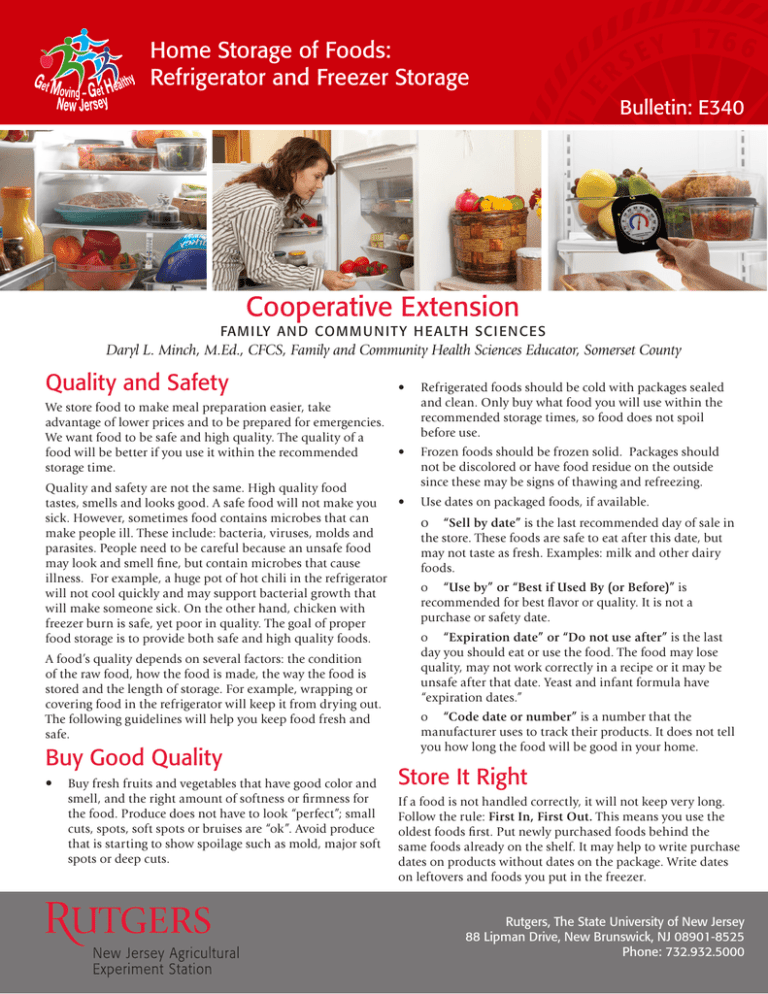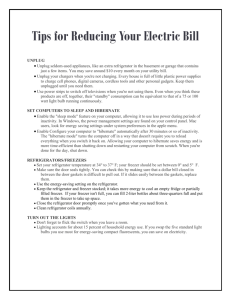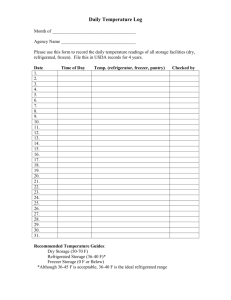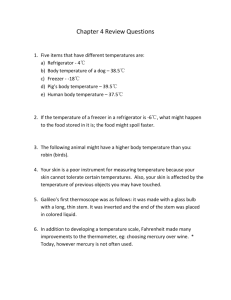
Home Storage of Foods:
Refrigerator and Freezer Storage
Bulletin: E340
Cooperative Extension
FAM I LY AN D CO M M U N I T Y H E A LT H SC I E NC E S
Daryl L. Minch, M.Ed., CFCS, Family and Community Health Sciences Educator, Somerset County
Quality and Safety
We store food to make meal preparation easier, take
advantage of lower prices and to be prepared for emergencies.
We want food to be safe and high quality. The quality of a
food will be better if you use it within the recommended
storage time.
Quality and safety are not the same. High quality food
tastes, smells and looks good. A safe food will not make you
sick. However, sometimes food contains microbes that can
make people ill. These include: bacteria, viruses, molds and
parasites. People need to be careful because an unsafe food
may look and smell fine, but contain microbes that cause
illness. For example, a huge pot of hot chili in the refrigerator
will not cool quickly and may support bacterial growth that
will make someone sick. On the other hand, chicken with
freezer burn is safe, yet poor in quality. The goal of proper
food storage is to provide both safe and high quality foods.
A food’s quality depends on several factors: the condition
of the raw food, how the food is made, the way the food is
stored and the length of storage. For example, wrapping or
covering food in the refrigerator will keep it from drying out.
The following guidelines will help you keep food fresh and
safe.
Buy Good Quality
• Buy fresh fruits and vegetables that have good color and
smell, and the right amount of softness or firmness for
the food. Produce does not have to look “perfect”; small
cuts, spots, soft spots or bruises are “ok”. Avoid produce
that is starting to show spoilage such as mold, major soft
spots or deep cuts.
• Refrigerated foods should be cold with packages sealed
and clean. Only buy what food you will use within the
recommended storage times, so food does not spoil
before use.
•
Frozen foods should be frozen solid. Packages should
not be discolored or have food residue on the outside
since these may be signs of thawing and refreezing.
•
Use dates on packaged foods, if available.
o “Sell by date” is the last recommended day of sale in the store. These foods are safe to eat after this date, but
may not taste as fresh. Examples: milk and other dairy
foods.
o
“Use by” or “Best if Used By (or Before)” is
recommended for best flavor or quality. It is not a
purchase or safety date.
o
“Expiration date” or “Do not use after” is the last
day you should eat or use the food. The food may lose
quality, may not work correctly in a recipe or it may be
unsafe after that date. Yeast and infant formula have
“expiration dates.”
o
“Code date or number” is a number that the
manufacturer uses to track their products. It does not tell
you how long the food will be good in your home.
Store It Right
If a food is not handled correctly, it will not keep very long.
Follow the rule: First In, First Out. This means you use the
oldest foods first. Put newly purchased foods behind the
same foods already on the shelf. It may help to write purchase
dates on products without dates on the package. Write dates
on leftovers and foods you put in the freezer.
Rutgers, The State University of New Jersey
88 Lipman Drive, New Brunswick, NJ 08901-8525
Phone: 732.932.5000
Refrigerator:
•
Freezer burn on a food looks like a dry spot and food may
be white or gray in color. It is the result of cold air getting
to the food’s surface and drying the food out. Freezer
burn will not make you sick, but the food will be dry and
tough. Wrapping food tightly and sealing out air will help
protect the food.
•
Ice crystals or frost may appear on food or in packaging
during storage in the freezer. This is moisture evaporation
from the food and will result in a dried out product. It
is more common in baked goods, fruit and vegetables.
Wrapping food tightly, sealing out air and following
storage guidelines will help minimize moisture loss.
•
Frozen food stored beyond the recommended time will
be safe to eat. However, the food may be dried out, tough
and flavor or texture may change.
• Keep a thermometer in the refrigerator and keep the
temperature at 35° F to 40° F.
•
Open the door as little as possible. Every time the door
opens, warm air enters which can raise the temperature
of the refrigerator and lower food quality. It also increases
electricity costs.
•
Wrap or cover food to prevent the loss of flavor and
moisture. It also prevents the mixing of flavors and odors,
so your milk does not taste like onion or fish.
•
Place raw meat, poultry, or fish on a plate or tray and put
on the lowest shelf in the refrigerator. This will keep the
food from dripping onto and contaminating other foods.
•
Wrap or package leftovers to keep them from leaking and
drying out. Plastic bags and containers work well. Most
leftovers are best used within 3 to 4 days.
Keep It Clean
Since bacteria can get into food during food handling, keep
everything – hands, counter tops, dishes, utensils, and the
refrigerator and freezer - clean. Wash your hands with soap
and warm water for at least 20 seconds before putting away
groceries, preparing food, or putting away leftovers. This will
greatly reduce the risk spreading bacteria and viruses and
getting sick.
For More Food Safety Information:
Websites:
Rutgers Cooperative Extension: njaes.rutgers.edu
FightBAC!™: www.fightbac.org
Food Safety and Inspection Service : fsis.usda.gov
Freezer:
General: www.FoodSafety.gov
• Keep a thermometer in the freezer and keep the
Call the county Cooperative Extension office or your county
government. Offices are listed on the NJAES website.
temperature at or below 0°F. If the temperature is
higher than 0°F, the food will not keep its good quality
as long.
•
Keep your freezer full with food or add ice. A full freezer
holds its temperature better.
•
Open the door as little as possible. Every time the door
opens, warm air enters which can raise the temperature
of the freezer and lower food quality. It also increases
electricity costs.
•
Wrap foods in moisture-proof, freezer-weight wrap or
use plastic containers. Examples of wrap are plastic
freezer bags, heavy foil, and freezer paper. Label and date
packages.
•
Keep a list of foods in the freezer. This will help with
meal planning, knowing what to purchase, and minimize
searching for food.
E340 - Refrigerator & Freezer Storage
Telephone:
USDA Meat & Poultry Hotline: Weekdays 10 to 4 PM EST,
1-800-535-4555
Food and Drug Administration Food Information Line:
1-888-723-3366
Food
DAIRY
Refrigerator: 35° - 40°F Freezer: 0°F
(*=not recommended; (*=not recommended;
NA=not applicable)
NA=not applicable)
Buttermilk
Butter or margarine
1-2 weeks
1-3 months
3 months
6-9 months
Condensed & evaporated
milk (opened)
Cottage cheese, Ricotta
Cream - heavy, whipping,
half & half, light
(unwhipped)
Cream - whipped in
aerosol can
Milk
Cheese (hard) - cheddar,
Montery Jack, swiss,block
Parmesan, etc.
Cheese - grated or
shredded
Cheese - processed food
products
Cheese - cream (opened)
Cheese spreads &
processed cheese
Ice cream, frozen yogurt
Sour cream
Yogurt
4-5 days
*
1 week
10 days
*
*
3 months
*
1 week
6 months unopened &
3-4 months opened
1 month
6 months
1 month
3-4 months
3-4 weeks
4 months
2 weeks
3-4 weeks
*
*
*
1-3 weeks
7-14 days
2-4 months
*
1-2 months
Chops
Pre-stuffed uncooked chops
Roasts
Steak
Stew meat
Ground meat
Sausage, smoked pepperoni, jerky
Sausage - raw from chicken,
turkey, beef or pork
Sausage - summer (labeled
"keep refrigerated"
3-5 days
1 day
3-5 days
3-5 days
1-2 days
1-2 days
2-3 weeks
4-6 months
*
4-12 months
6-12 months
3-4 months
3-4 months
1-2 months
1-2 days
1-2 months
unopened - 3 months;
opened 3 weeks
1-2 months
BEEF, LAMB, PORK, VEAL
E340- Refrigerator & Freezer Storage
Notes
Read labels, some
margarines do not
freeze well
Check package date
Food
BEEF, LAMB, PORK, VEAL
(cont’d)
Smoked breakfast links or patties
Whole ham (fully cooked)
Half ham (fully cooked)
Sliced ham (fully cooked)
Canned ham - labeled
"keep refrigerated"
Bacon
Corned beef
Hotdogs
OTHER MEATS
Bison (Buffalo)
Other game - Elk, rabbit
Refrigerator: 35° - 40°F Freezer: 0°F
(*=not recommended; (*=not recommended;
NA=not applicable)
NA=not applicable)
7 days
7 days
3-5 days
3-4 days
6-9 months unopened &
3-5 days opened
7 days
5-7 days (in pouch with
juices)
2 weeks unopened &
1 week opened
1-2 months
1-2 months
1-2 months
1-2 months
1-2 months
Ground or stew meat 2 days; larger cuts 3-5 days
3-5 days
Ground or cut-up 4 months; Chops, steak &
roasts - 6-9 months
6-9 months
Notes
Do not freeze
in can
1 month
1 month (drained)
1-2 months
Sealed - 2 weeks (or 1 week 1-2 months
after "Use-By" date); opened
7 days
Variety Meats - heart, liver, kidney, 1-2 days
3-6 months
tongue, etc.
Venison - Roasts, steaks, chops
3-5 days
9-12 months
Less time for ground,
stew meat or chops.
Longer time for roast.
Smoked game, vacuum-sealed
DELI & VACUUM-PACKED MEAT PRODUCTS
Lunch meats (vacuum packed &
unopened)
Lunch meats (vacuum packed or
fresh cut, opened)
2 weeks
1-2 months
3-5 days
1-2 months
Meat & meat casseroles
3-4 days
2-3 months
Gravy & meat broth
3-4 days
2-3 months
Soups & stews
3-4 days
2-3 months
COOKED, LEFTOVER MEAT
E340 - Refrigerator & Freezer Storage
Less time for ground,
stew meat or chops.
Longer time for roast.
Food
POULTRY PRODUCTS
Refrigerator: 35° - 40°F Freezer: 0°F
(*=not recommended; (*=not recommended;
NA=not applicable)
NA=not applicable)
1 year
9 months
3-4 months
3-4 months
6 months
6-12 months
Chicken or turkey, whole
Chicken or turkey, pieces
Giblets
Ground turkey & chicken
Duck, whole
Game birds - goose,
pheasant, quail
1-2 days
1-2 days
1-2 days
1-2 days
1 day
1-2 days
Fried chicken
Cooked casseroles
Plain pieces
Pieces with broth/gravy
Nuggets or patties
3-4 days
3-4 days
3-4 days
3-4 days
3-4 days
4 months
4-6 months
4 months
6 months
1-3 months
3-5 weeks
2-4 days
1 week
10 days unopened &
3 days opened
commercial 3-5 days;
homemade 2-4 days
*
1 year
*
unopened - 1 year; opened not
recommended
commercial 6 months,
homemade not recommended
COOKED, LEFTOVER POULTRY
EGGS
Fresh in shell
Raw yolks, whites
Hardcooked
Liquid pasteurized eggs or
egg substitute
Eggnog
FISH
Fresh finfish
3 days
Lean fish – cod, flounder,
haddock, halibut, pollack,
ocean perch, sea trout & rock
fish
3 days
Fatty fish – bluefish,
mackerel, mullet, smelts,
salmon, swordfish, trout,
tuna, etc.
E340 - Refrigerator & Freezer Storage
Notes
Keep finfish &
shellfish on ice in the
refrigerator
6-8 months
2-3 months
Food
Fresh or live shellfish
Live crabs & lobster
Refrigerator: 35°- 40°F Freezer: 0°F
Notes
(*=not recommended; (*=not recommended;
NA=not applicable)
NA=not applicable)
1-2 days
*
Live clams, mussels & oysters 4-5 days
*
Shrimp, scallops, crawfish,
squid
4 days
5 months
Smoked fish
FRUITS
14 days
2 months
Apples
Apricots
6 weeks
3-4 days
12 months, cooked
12 months
Bananas
*
12 months
Berries
Cherries
Grapes
Citrus: grapefruit, lemons,
limes & oranges
Guavas
Kiwis (Chinese
gooseberry)
Mangos
Melons
Papayas
Peaches & nectarines
Pears
Pineapples
Plantains
Plums
Pomegranate
Rhubarb
1-2 days
1 week
1 week
2-8 weeks
12 months
12 months
1 month
3-4 months
1-2 days
1-2 days
12 months
12 months
2-3 days
3-4 days
1 week
3-4 days
3-4 days
3-5 days
*
3 days
3 months whole
1 week
12 months
12 months
12 months
12 months
12 months
12 months
12 months
12 months
3 months - whole seeds
12 months
Apple or Cider
Bottled or canned (opened)
Concentrate
6 Days
3-4 Days
6 Days
NA
NA
1 Year
FRUIT JUICES
E340 - Refrigerator & Freezer Storage
Contact Family &
Community Health Sciences
for specific directions on
how to freeze fruit.
Refrigerating bananas will
cause the skin, but not the
flesh to darken.
Food
VEGETABLES
Refrigerator: 35° - 40°F Freezer: 0°F
Notes
(*=not recommended; (*=not recommended;
NA=not applicable)
NA=not applicable)
Contact Family &
Community Health Sciences
for specific directions on
how to freeze vegetables.
Asparagus
3-4 days
Avocados
3-5 days
Beans, shell - lima, fava, soy 2 -3 days in pod &
1-2 days shelled
Beets
3 weeks
Bok Choy
1-3 days
Broccoli
4 days
Brussel Sprouts
3-5 days
Cabbage - green, red,
1-2 weeks
napa, savoy
Carrots
2 weeks
Cauliflower
5 days
Celery
1-2 weeks
12 months
12 months
10-12 months
Chilies & hot peppers
Cilantro
2 weeks
1-3 days
12 months
*
Corn
1-2 days
Cucumbers
Eggplant
Green beans
Greens – spinach, collards,
swiss chard, kale, mustard,
etc.
Jerusalem artichokes
Jicama
Kohlrabi - leaves
Kohlrabi - stem
Leeks
Mushrooms
1 week
3-4 days
3-5 days
1-2 days
On cob - 8-10 months;
kernals - 12 months
*
12 months
8 months
10-12 months
1 week
2-3 weeks, uncut
2-3 days
1 week
1 week
3-7 days
12 months
12 months
12 months
12 months
3-6 months
10-12 months
Onions, green - scallions
Okra
Parsley
1-2 weeks
3-4 days
2-3 days
3-6 months
12 months
*
E340 - Refrigerator & Freezer Storage
12 months
*
12 months
12 months
12 months
12 months
12 months
1 Year
Freeze for cooked dishes
only, otherwise soggy
Stand roots or stems in
water & cover loosely with
plastic bag in refrigerator
Use immediately for best
flavor
Unopened, packaged
mushrooms keep longest
Food
VEGETABLES (cont’d)
Refrigerator: 35° - 40°F Freezer: 0°F
Notes
(*=not recommended; (*=not recommended;
NA=not applicable)
NA=not applicable)
Peas
1-2 days
12 months
Peppers - green, red, yellow
Radishes - red, Diakon
Squash, hard
Squash, summer - yellow
crookneck, zucchine
Tomatillos
Tomatoes
1 week
2 weeks
*
4-5 days
6-8 months
*
12 months
12 months
1 month
2-3 days
12 months
12 months
Yuca (Cassava)
*
12 months
BAKED PRODUCTS
Breads
Bread, yeast
*
2-3 months
Muffins
*
2-4 months
Quick breads
*
2-4 months
Pancakes & waffles
*
2-4 months
Rolls, yeast
*
2-3 months
Angel, Chiffon & Sponge
*
6 months
Cheesecake
7 days
4-6 months
Fruitcake
*
12 months
Layer cake
Plain, buttercream icing
- not necessary; custard,
cream or whipped cream
filling or icing - refrigerate
*
Plain - 3 months
Iced - 6 months
Cakes
Cookies
Pies
Chiffon & custard
Fruit
Pumpkin
Unbaked fruit
Quiche
E340 - Refrigerator & Freezer Storage
3-4 days
1-2 days
3-4 days
*
3-4 days
baked - 6 months, unbaked
dough - 4 months
*
6-8 months
baked 1-2 months
4 months
baked 1-2 months
use immediately for best
flavor
For best flavor do not
refrigerate
In general, do not
refrigerate. Breads stale
faster in the refrigerator.
However, refrigeration
may reduce mold growth
if home is hot & humid.
Food
Refrigerator: 35° - 40°F Freezer: 0°F
(*=not recommended; (*=not recommended;
NA=not applicable)
NA=not applicable)
Notes
Expressed breast milk
3-5 days
5° F - 2 weeks; 0°F 3-6
months; -4° - 6-12 months
Formula
2 days
Storage time depends on
temperature and conditions.
Breast milk has natural
antibacterial qualities & may be
stored on a counter at 60°-85°F
for 3-4 hours. See reference list
for more information.
*
Strained fruits &
vegetables
Strained meat & eggs
2-3 days
6-8 months
1 day
1-2 months
BABY FOOD
Liquid
Solids (open or freshly made)
Strained meat/vegetable 1-2 days
combination
Homemade baby foods 1-2 days
CONDIMENTS
Ketchup & Barbecue
sauce (opened)
Mayonnaise
(commercial, opened)
Mustard (opened)
6-8 months
3-4 months
8-12 months
*
2 months
*
8-12 months
*
*
Salad dressing - bottled 4 months
(opened)
MISCELLANEOUS
Chestnuts
6 months
*
Guacamole
Homemeade - 1-3 days;
commercial - 5-7 days
Homemade - 2-7 days;
commercial - 5-7 days
6+ months
6 months
1 year
1 week
3-4 days
3-5 days
1 month
1-2 months
*
6-8 months
*
1 week
5 months
Hummus
Nuts
Pasta, fresh
Pizza
Salads - chicken, turkey,
ham, tuna & pasta
Syrups - maple or
panckake
Tofu
E340 - Refrigerator & Freezer Storage
*
May store in cool & dry cabinet
for 3-4 months. Refrigerate or
freeze for longer storage.
Store in water in refrigerator &
replace water daily.
Foods that do not freeze well
Because of flavor changes
•
•
•
•
Garlic (uncooked)
Onion (raw; better cooked or as ingredient)
Salt substitutes (not sodium chloride)
Spices – clove, sage (flavor is stronger or bitter)
• Vanilla, artifical flavor (not real vanilla)
Because of texture changes
•
•
•
•
•
•
•
•
•
•
Cake icing - soft or boiled (butter cream freezes well)
Cream sauces
Custard or cream filling
Egg whites (cooked) & meringue
Fried foods (homemade)
Gelatin
Mayonnaise or salad dressing
Lettuce
Pasta (cooked, unsauced)
Potatoes
© 2012 Rutgers, The State University of New Jersey. All rights reserved.
For a comprehensive list of our publications visit www.njaes.rutgers.edu
June 2012
Cooperating Agencies: Rutgers, The State University of New Jersey, U.S. Department of Agriculture, and County Boards of Chosen Freeholders. Rutgers Cooperative Extension, a unit of the
Rutgers New Jersey Agricultural Experiment Station, is an equal opportunity program provider and employer.
Rutgers, The State University of New Jersey
88 Lipman Drive, New Brunswick, NJ 08901-8525
Phone: 732.932.5000





